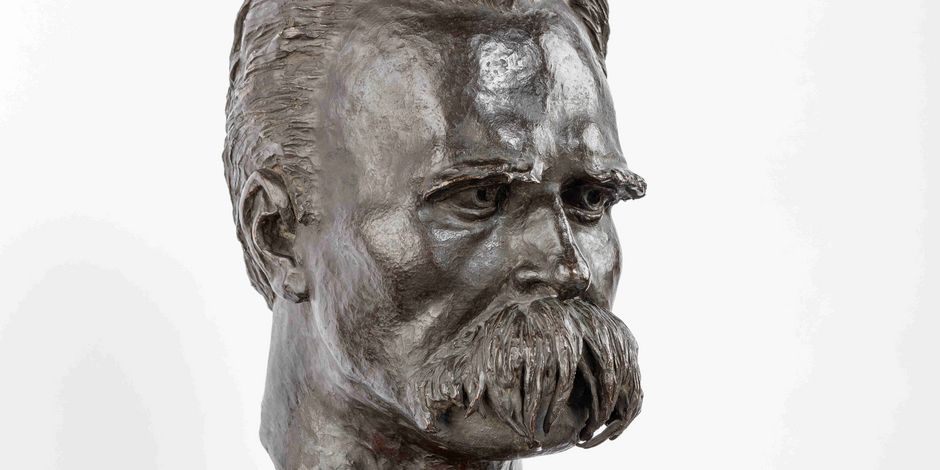Projects of the Klassik Stiftung Weimar are funded by the European Regional Development Fund (ERDF) and the Free State of Thuringia, represented by the State Chancellery of Thuringia, Department of Culture and the Arts.

The Klinger bust
How Max Klinger created what is possibly the most famous Nietzsche bust from a flawed death mask.
Elisabeth Förster-Nietzsche was ardently devoted to increasing her brother’s posthumous fame. But this project suffered setbacks from time to time. Neither the Nietzsche-Archiv edition projects nor the artists commissioned to produce Nietzsche’s portraits delivered the desired results. To make matters worse, the philosopher died before Max Klinger or another distinguished sculptor could create a portrait bust of Nietzsche while alive. Unfortunately, neither Klinger nor Ernst Moritz Geyger could come to Weimar in time to make a death mask. Therefore, the task fell to the inexperienced painter Curt Stoeving. The mask, which was made two days after Nietzsche’s death, contained several flaws which could no longer be corrected and limited its propagandistic usefulness. The most noticeable flaw was the crooked nose pressed to the left. The right eyebrow contained a deep cleft and seemed to hang down limply. And the flattened, unstructured beard was a strange sight to see.
Many contemporaries were impressed nonetheless by this final “portrait” of the philosopher. Max Klinger artistically examined the mask and tried – not least of all at Förster-Nietzsche’s request – to “straighten Nietzsche’s nose” and correct the “distortions caused by the plaster cast”. The death mask slowly evolved into the image of a living person. The artist reported back to Weimar on his progress:
“The correction of the nose required offsetting the visibly swollen left cheek, and the construction of the eyebrows, the beard and mouth – and then after going so far, the eyes had to be slightly realigned. An attempt to present the mask of the deceased as one of the living seemed an obvious step, and now that I’ve come so far, I would like to make the mask into a complete head [...]” (Max Klinger to Elisabeth Förster-Nietzsche on 2 Januar 1902)
Instead of correcting the death mask, Klinger worked on creating an entirely sculpted head portrait, which his moulder Pierre Bingen created using the lost-wax technique in 1902. The extraordinary piece is quite impressive for its shaggy moustache, which no other moulding technique could have rendered better, and the freely modelled neck that seamlessly merges into the base. Harry Graf Kessler presented the bust at the Klinger exhibition in Weimar in 1903 but chose not to purchase it. Its specific formal characteristics prevented it from being used as a model for plaster copies or miniature bronze reproductions.
But that changed with the marble herm which Klinger created for the Nietzsche-Archiv shortly thereafter. Like the material itself, the herm exudes greater calmness but still possesses the same visual “trademarks” – the swept back shock of hair, the shaded gaze under the bushy eyebrows and the massive moustache which completely covers the mouth. What was once a partially flawed death mask had become one of the most famous Nietzsche portraits in the art world. The bronze bust with its outstanding craftsmanship and artistry recently returned to Weimar as part of Martin Burger’s Nietzsche collection. Copies of the herm can now be found around the world.
Max Klinger (1857–1920): Friedrich Nietzsche, 1902
Dimensions: 49.5 x 17 x 24.5 cm
Material/technique: bronze
Inv. no.: Pl-2018/2.1
Signed and dated: „MK 1902“
Foundry stamp: „Cire perdue P. Bingen fondeur“
Provenance: Nietzsche collection of Martin Burger
Collection: Sculpture collection of the museums of the Klassik Stiftung Weimar

